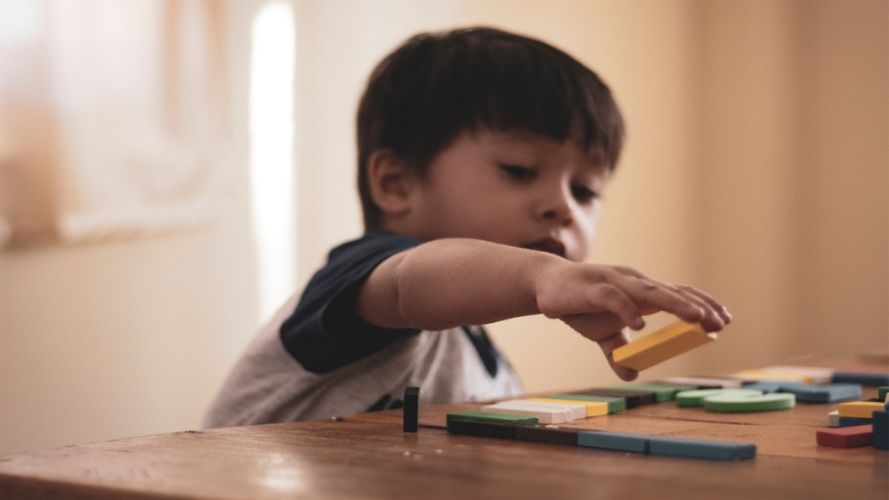Mom! Where is my library book?”, yells your child from the other room.
“Where did you last put it?”
“I don’t remember!”
Does this sound familiar? It does to me! Backpacks, books, shoes, and the list goes on. Memory is an important part of every child’s growth and it is something that has to be taught. Fortunately, there are many games you can play with your child to help boost their memory skills.
Not only will it help your child but playing these games with them can help you as well. Have you ever walked into a room and forgotten why you went there in the first place? Me too. We all need a little memory boosting now and then!
#1 Memory matching game
We simply had to mention this one first! This is the game we all remember from our own childhood and is still popular today. The Memory Game has stood the test of time and I can imagine it still being around for the next generation.
How to Play:
The game comes with a large set of cardboard cards with various pictures on one side. There are two identical pictures in the stack. You simply lay the cards face down, scramble, and then organize them in a large square or rectangular shape. You each take turns flipping over two cards with the aim of trying to find matching pairs. If you get a matching pair you get to keep the cards as your reward.
The object of the game is to try and remember cards that have been shown so that you can match them up to other cards as you go along. The person with the most reward cards at the end of the game is the winner!
This game can be bought at pretty much any superstore or toy store, such as Wal-mart, Target, and K-mart. You can get the Disney Classic Matching Game over at Amazon.
#2 DIY memory matching game
You can easily make your own memory matching game with items you already have in your home. This can even be a project you and your child can do together. Just follow the same playing instructions as the store bought game.
Supplies:
- Cardboard (leftover cereal boxes work great)
- Markers
- Scissors
Instructions:
Cut the cardboard into 52 equal sized squares.
Using the markers, mark a letter from the alphabet on each square. Make sure to double each letter so that they can be matched up.
#3 I Went to the store..
This is a game that you can do with your child anywhere at any time. It’s an excellent way to pass the time while working those memory skills.
How to play:
You simply start off by saying “I went to the store and bought a __” and listing an item you bought such as an apple. The next person repeats what the other one said and then adds an item. You simply repeat while adding an item with each turn until someone forgets one of the items in sequence.
#4 Online memory games
There are many online resources you can utilize to help your child with their memory. If you have a tech-savvy kid who loves playing video games then they may enjoy an online memory game.
Memozor has a ton of different memory games for kids in specific age ranges. They even have multiplayer games, printable games, and games for adults.
How to play:
The Jungle Animal memory game is a quick and simple game for ages 4 and up. Your child simply clicks the images to try and match up pairs of jungle animals. The fun part about this game is that it is on a timer so your child can try to beat their score.
#5 Picture bingo
This game is similar to the memory matching game yet with a twist. This game is set up just like bingo except for your child matches rows of pictures.
How to play:
Each child gets a bingo card and tokens. Cards are then spread out face down in the middle. Each child takes a turn picking a card to see if it matches a card on their board. If they have a match they get to go again. The first one to have a row of tokens gets to yell out “Bingo”, and they win.
Amazon has several versions of this game available. A good example is the Match it! Bingo – Picture Word Game.
#6 Where’s the ball?
This is the classic carnival game that usually leaves the spectator frustrated because the entertainer uses slight of hand to trick their customers. You can play this one with your child to help boost their memory (without using slight of hand, of course).
How to play:
All you need is three plastic cups of the same size and color, and a small cotton ball. You simply place the cups face down and then have your child watch as you place the cotton ball beneath one of the cups. You then slide the cups around as your child watches, keeping their eye on the cup with the ball. Once you’ve stopped you ask your child which cup contains the ball.
#7 Simon
This is an oldie but goodie. I remember playing this one for hours when I was a kid, hitting those colored buttons in a frenzy as the game went faster and faster. There are now different versions of the electronic game called Simon.
How to play:
The game is set up with four different colored buttons. Your child will watch as the buttons light up in a sequence. When the pattern stops your child must push the buttons in the same pattern and order as was demonstrated. Each round gets a little more difficult and a little faster.
You can get the traditional version over at Amazon. You can also play an online version of Simon at Learning Games for Kids.
#8 What Is missing?
This game can be played on a rainy afternoon using items that you have around the house. Unlike other matching games, your child actually has to figure out what is missing.
How to play:
Gather up several items from around the house such as various toys. Place them on the table or a tray and have your child study them closely. Remind them to try and remember each item. It may help if your child names each item out loud and focuses on certain details. Then cover the items with a large towel or sheet and have your child look away. You then remove one of the items. Your child can look back now as you uncover the leftover items. Their job is to try and remember which item is missing.
Step away from the task at hand and enjoy the sensory overload. Let your kid jump in the soapy runoff and make footprint tracks on the pavement. Build up the experience so that they look forward to doing it again!
#9 Bop it!
I got this game for my kids one year and they absolutely loved it. To tell the truth, I rather enjoyed it myself! This is an electronic game that is similar to Simon yet with a crazy and wacky twist.
How to play:
This game has fun commands that tell your child to bop it, twist it, and pull it in specific sequences that change all the time. There are different levels of play with this game for different ages. Younger children can use the voice commands while older children can try their hand at the sounds that differ for each action. The game also increases with speed at each level.
You can find various versions of Bop It! at Amazon. The also carry it at local toy stores and superstores.
Tips for Helping to boost your child’s memory
Kids need working memory to help them learn and follow instructions and directions. It is how they work with the information they store in their short-term memory. While memory games for kids can help them learn how to remember things in a fun and exciting way, you can also help your child to boost their memory skills by incorporating certain activities into their daily life.
Visualization
Kids need working memory to help them learn and follow instructions and directions. It is how they work with the information they store in their short-term memory. While memory games for kids can help them learn how to remember things in a fun and exciting way, you can also help your child to boost their memory skills by incorporating certain activities into their daily life.
Multisensory
Sometimes kids are able to recall details and remember important facts if they can associate that memory with other senses. Having your child write things down can offer them both the visual sense of the memory as well as the action of writing it down. Discussing future events while playing a game or other activities together can also help. These acts will help your child to retain that memory longer through the use of their other senses.








